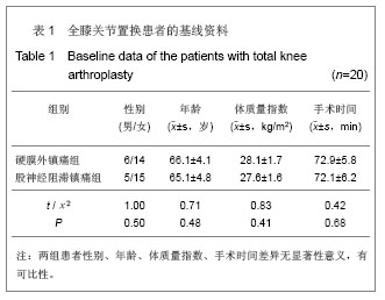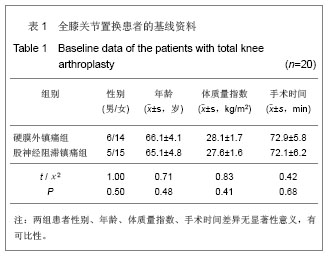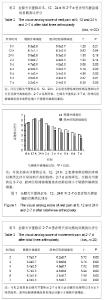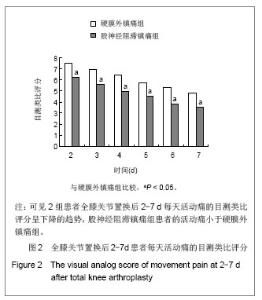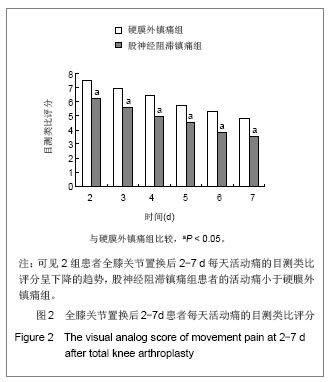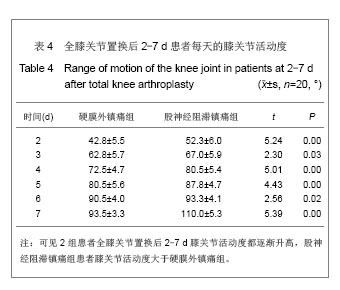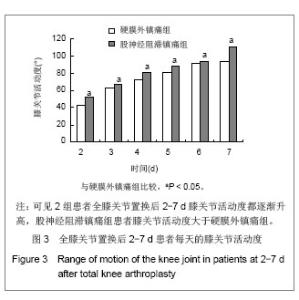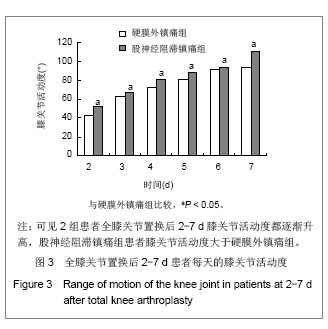Chinese Journal of Tissue Engineering Research ›› 2013, Vol. 17 ›› Issue (22): 4005-4012.doi: 10.3969/j.issn.2095-4344.2013.22.003
Previous Articles Next Articles
Multimodal analgesia after total knee arthroplasty
Liu Bing-shan, Li Guo-jun, Wang Xiao, Zhang Song, Liu Yang, Zhang Yong-le
- Department of Orthopedics, Huaihe Hospital Affiliated to Henan University, Kaifeng 475000, Henan Province, China
-
Online:2013-05-28Published:2013-05-28 -
Contact:Li Guo-jun, M.D., Associate professor, Department of Orthopedics, Huaihe Hospital Affiliated to Henan University, Kaifeng 475000, Henan Province, China lgjhndx@yahoo.com.cn -
About author:Liu Bing-shan★, Studying for master’s degree, Attending physician, Department of Orthopedics, Huaihe Hospital Affiliated to Henan University, Kaifeng 475000, Henan Province, China -
Supported by:Henan Medical Science and Technology Innovation Project*
CLC Number:
Cite this article
Liu Bing-shan, Li Guo-jun, Wang Xiao, Zhang Song, Liu Yang, Zhang Yong-le. Multimodal analgesia after total knee arthroplasty[J]. Chinese Journal of Tissue Engineering Research, 2013, 17(22): 4005-4012.
share this article
| [1]Li DW, Xu Y, Wu HS. Shiyong Yixue Zazhi. 2007;23(18): 2814-2815.李东文,徐燕,吴海山.全膝关节置换术围手术期疼痛控制现状及思考[J].实用医学杂志,2007,23(18):2814-2815.[2]Zhang YL, Xie XX, Yan SX. Zhongguo Yiyao Daobao. 2007; 4(29):61-62. 张亚丽,谢秀霞,闫淑霞.人工全髋关节置换术围术期病人的护理[J].中国医药导报,2007,4(29):61-62. [3]Allen HW, Liu SS, Ware PD, et al. Peripheral nerve blocks improve analgesia after total knee replacement surgery. Anesth Analg. 1998;87(1):93-97.[4]Szczukowski MJ Jr, Hines JA, Snell JA, et al. Femoral nerve block for total knee arthroplasty patients: a method to control postoperative pain. J Arthroplasty. 2004;19(6):720-725.[5]Mahoney OM, Noble PC, Davidson J, et al. The effect of continuous epidural analgesia on postoperative pain, rehabilitation, and duration of hospitalization in total knee arthroplasty. Clin Orthop Relat Res. 1990;(260):30-37.[6]Fowler SJ, Symons J, Sabato S, et al. Epidural analgesia compared with peripheral nerve blockade after major knee surgery: a systematic review and meta-analysis of randomized trials. Br J Anaesth. 2008;100(2):154-164.[7]Shanthanna H, Huilgol M, Manivackam VK, et al. Comparative study of ultrasound-guided continuous femoral nerve blockade with continuous epidural analgesia for pain relief following total knee replacement. Indian J Anaesth. 2012; 56(3):270-275.[8]Tantry TP, B G M, Hukkery R. Use of a single injection femoral nerve block in the patients of total knee replacement with concomitant epidural analgesia. J Clin Diagn Res. 2012;6(10): 1744-1748.[9]Osawa M, Takahama Y, Kondo Y. Comparison of postoperative pain relief by continuous femoral nerve block and that by epidural block during physiotherapy after minimally invasive surgery of total knee arthroplasty and uni-condylar knee arthroplasty. Masui. 2012;61(12): 1316-1323.[10]Ishiguro S, Yokochi A, Yoshioka K, et al. Technical communication: anatomy and clinical implications of ultrasound-guided selective femoral nerve block. Anesth Analg. 2012;115(6):1467-1470.[11]Dorr LD, Raya J, Long WT, et al. Multimodal analgesia without parenteral narcotics for total knee arthroplasty. J Arthroplasty. 2008;23(4):502-508.[12]Ranawat AS, Ranawat CS. Pain management and accelerated rehabilitation for total hip and total knee arthroplasty. J Arthroplasty. 2007;22(7 Suppl 3):12-15.[13]Kim JH, Cho MR, Kim SO, et al. A comparison of femoral/sciatic nerve block with lateral femoral cutaneous nerve block and combined spinal epidural anesthesia for total knee replacement arthroplasty. Korean J Anesthesiol. 2012; 62(5):448-453.[14]Zongxing WZZ. Tengtong Yixue Zazhi. 1994,2(4):153-155.宗行万之助.疼痛的估价——用特殊的视觉模拟评分法作参考(VAS)[J].疼痛学杂志,1994,2(4):153-155.[15]Guan ZP, Lv HS, Wu C, et al. Zhonghua Waike Zazhi.2003; 41:37-40.关振鹏,吕厚山,吴淳,等.人工关节置换术后肺栓塞的早期诊断和处理[J].中华外科杂志,2003,41:37-40.[16]Li L, Luo M, Feng J. Zhongguo Jiaoxing Waike Zazhi. 2009;17: 1139-1141.李丽,罗曼,冯洁,等.连续股神经阻滞镇痛对老年人全膝关节置换术后康复功能的影响[J].中国矫形外科杂志,2009,17:1139- 1141.[17]Abdallah FW, Brull R. Is sciatic nerve block advantageous when combined with femoral nerve block for postoperative analgesia following total knee arthroplasty? A systematic review. Reg Anesth Pain Med. 2011;36(5):493-498.[18]Affas F, Nygårds EB, Stiller CO, et al. Pain control after total knee arthroplasty: a randomized trial comparing local infiltration anesthesia and continuous femoral block. Acta Orthop. 2011;82(4):441-447.[19]Asakura Y, Tsuchiya H, Mori H, et al. Reduction of the incidence of development of venous thromboembolism by ultrasound-guided femoral nerve block in total knee arthroplasty. Korean J Anesthesiol. 2011;61(5):382-387.[20]Asakura Y, Yano T, Takagi H, et al. The incidence of development of motor blockade by ropivacaine is concentration dependent, and most studies regarding the continuous FNB after total knee arthroplasty used 0.2% to 0.3%ropivacaine. J Arthroplasty. 2010;25(5):836; author reply 837-838.[21]Aveline C, Le Roux A, Le Hetet H, et al. Postoperative efficacies of femoral nerve catheters sited using ultrasound combined with neurostimulation compared with neurostimulation alone for total knee arthroplasty. Eur J Anaesthesiol. 2010;27(11):978-984.[22]Baranovi? S, Maldini B, Milosevi? M, et al. Peripheral regional analgesia with femoral catheter versus intravenous patient controlled analgesia after total knee arthroplasty: a prospective randomized study. Coll Antropol. 2011;35(4): 1209-1214.[23]Jia DL, Li SQ, Yu JK, et al. Zhongguo Tengtong Yixue Zazhi. 2008;14:214-217.贾东林,李水清,余家阔,等.罗哌卡因或利多卡因持续股神经阻滞用于膝关节置换术后患者康复镇痛的临床研究[J].中国疼痛医学杂志,2008,14:214-217.[24]Nader A, Kendall MC, Wixson RL, et al. A randomized trial of epidural analgesia followed by continuous femoral analgesia compared with oral opioid analgesia on short- and long-term functional recovery after total knee replacement. Pain Med. 2012;13(7):937-947.[25]Sugar SL, Hutson LR Jr, Shannon P, et al. Comparison of extended-release epidural morphine with femoral nerve block to patient-controlled epidural analgesia for postoperative pain control of total knee arthroplasty: a case-controlled study. Ochsner J. 2011;11(1):17-21.[26]Barker MC. Combined spinal/general anesthesia with postoperative femoral nerve block for total knee replacement in a patient with familial hyperkalemic periodic paralysis: a case report. AANA J. 2010;78(3):191-194.[27]Barrington MJ, Olive DJ, McCutcheon CA, et al. Stimulating catheters for continuous femoral nerve blockade after total knee arthroplasty: a randomized, controlled, double-blinded trial. Anesth Analg. 2008;106(4):1316-1321, table of contents. [28]Scott DA, Chamley DM, Mooney PH, et al. Epidural ropivacaine infusion for postoperative analgesia after mafor lower abdominal surgery-a dose finding study. Anesth Analg. 1995;81:982-986. [29]Zhonghua Yixuehui Guke Fenhui. Zhongguo Shequ Yishi. 2012;21(28):13.中华医学会骨科学分会.骨科常见疼痛的处理专家建议[J].中国社区医师,2012,21(28):13.[30]Johnson CB, Steele-Moses SK. The use of continuous femoral nerve blocks versus extended release epidural morphine: a study comparing outcomes in total knee arthroplasty procedures. Orthop Nurs. 2011;30(1):44-53.[31]Yadeau JT, Liu SS, Rade MC, et al. Performance characteristics and validation of the Opioid-Related Symptom Distress Scale for evaluation of analgesic side effects after orthopedic surgery. Anesth Analg. 2011;113(2): 369-377. [32]Lee AR, Choi DH, Ko JS, et al. Effect of combined single-injection femoral nerve block and patient-controlled epidural analgesia in patients undergoing total knee replacement. Yonsei Med J. 2011;52(1):145-150. [33]Beaupre LA, Johnston DB, Dieleman S, et al. Impact of a preemptive multimodal analgesia plus femoral nerve blockade protocol on rehabilitation, hospital length of stay, and postoperative analgesia after primary total knee arthroplasty: a controlled clinical pilot study. Scientific World J. 2012;2012:273821.[34]Bunburaphong P, Niruthisard S, Werawatganon T, Postoperative analgesia for total knee replacement: comparing between pre-and postoperative "3-in-1" femoral nerve block. J Med Assoc Thai. 2006;89(4):462-467.[35]Skinner HB, Shintani EY. Results of a multimodal analgesic trial involving patients with total hip or total knee arthroplasty. Am J Orthop. 2004;33(10):85-88.[36]Berend KR, Lombardi Jr AV, Mallory TH. Rapid recovery protocol for preoperative care of total hip and total knee arthroplasty patients. ClinOrthop Relat Res. 2004;11(429): 239-411.[37]Li DW, Xu Y, Wu HS. Zhongguo Zuzhi Gongcheng Yanjiu yu Linchuang Kangfu. 2007;11(36):7223-7226.李东文,徐燕,吴海山.全膝关节置换术后多模式围手术期疼痛控制方案在镇痛中的作用评价[J]. 中国组织工程研究与临床康复, 2007,11(36):7223-7226.[38]Cao F, Li CY, Kang XH. Zhongguo Xiandai Yisheng. 2009; 47(9): 50-52.曹飞,李超艺,康小红.人工全膝关节置换围手术期多模式联合镇痛的临床研究[J].中国现代医生,2009,47(9):50-52.[39]Zhu YL, Wu HS, Wu YL. Shiyong Guke Zazhi. 2009;15(2): 86-88.祝云利,吴海山,吴宇黎.全膝关节置换术围手术期复合镇痛疗效观察[J].实用骨科杂志,2009,15(2):86-88.[40]Zhang Y, Qian QR. Linchuang Junyi Zazhi. 2009;37(2): 320-323.张阳,钱齐荣.COX-2抑制剂与全膝关节置换术围术期镇痛[J].临床军医杂志,2009,37(2):320-323.[41]Wang HJ, Zhang DZ, Li SZ. Comparing the analgesic efficacy of continuous femoral nerve blockade and continuous intravenous analgesia after total knee arthroplasty. Zhonghua Yi Xue Za Zhi. 2010;90(33):2360-2362.[42]Paul JE, Arya A, Hurlburt L, et al. Femoral nerve block improves analgesia outcomes after total knee arthroplasty: a meta-analysis of randomized controlled trials. Anesthesiology. 2010;113(5):1144-1162.[43]Meunier A, Lisander B, Good L. Effects of celecoxib on blood loss,pain, and recovery of function after total knee replacement: a randomized placebo-controlled trial. Acta Orthop. 2007;78(5):661-667.[44]Reuben SS, Buvenandran A, Katz B, et al. A prospective randomized trial on the role of perioperative celecoxib administration for total knee arthroplasty: improving clinical outcomes. Anesth Analg. 2008;106(4):1258-1264.[45]Sundarathiti P, Ruananukul N, Channum T, et al. A comparison of continuous femoral nerve block (CFNB) and continuous epidural infusion (CEI) in postoperative analgesia and knee rehabilitation after total knee arthroplasty (TKA). J Med Assoc Thai. 2009;92(3):328-334.[46]Huang YM, Wang CM, Wang CT, et al. Perioperative celecoxib administration for pain management after total knee arthroplasty-a randomized, controlled study. BMC Musculoskelet Disord. 2008;9:77.[47]Cappelleri G, Ghisi D, Fanelli A, et al. Does continuous sciatic nerve block improve postoperative analgesia and early rehabilitation after total knee arthroplasty? A prospective, randomized, double-blinded study. Reg Anesth Pain Med. 2011; 36(5):489-492.[48]Chan MH, Chen WH, Tung YW, et al. Single-injection femoral nerve block lacks preemptive effect on postoperative pain and morphine consumption in total knee arthroplasty. Acta Anaesthesiol Taiwan. 2012;50(2):54-58. [49]Fu ZG, Qu YX, Mu XF. Zhongguo Tengtong Yixue Zazhi. 2009; 15(3):191-192.伏治国,瞿玉兴,牟晓峰.关节局部注射对全膝关节置换术后镇痛23例报告[J].中国疼痛医学杂志,2009,15(3):191-192.[50]Gao ZY, Wang YZ, Xu HM, et al. Zhongguo Jiaoxing Waike Zazhi. 2009;17(9):654-657.高正玉,王英振,徐红梅,等.膝关节局部注药在全膝关节置换镇痛中的应用[J].中国矫形外科杂志,2009,17(9):654-657. |
| [1] | Wang Jinjun, Deng Zengfa, Liu Kang, He Zhiyong, Yu Xinping, Liang Jianji, Li Chen, Guo Zhouyang. Hemostatic effect and safety of intravenous drip of tranexamic acid combined with topical application of cocktail containing tranexamic acid in total knee arthroplasty [J]. Chinese Journal of Tissue Engineering Research, 2021, 25(9): 1356-1361. |
| [2] | Lü Zhen, Bai Jinzhu. A prospective study on the application of staged lumbar motion chain rehabilitation based on McKenzie’s technique after lumbar percutaneous transforaminal endoscopic discectomy [J]. Chinese Journal of Tissue Engineering Research, 2021, 25(9): 1398-1403. |
| [3] | Chen Junming, Yue Chen, He Peilin, Zhang Juntao, Sun Moyuan, Liu Youwen. Hip arthroplasty versus proximal femoral nail antirotation for intertrochanteric fractures in older adults: a meta-analysis [J]. Chinese Journal of Tissue Engineering Research, 2021, 25(9): 1452-1457. |
| [4] | Chen Jinping, Li Kui, Chen Qian, Guo Haoran, Zhang Yingbo, Wei Peng. Meta-analysis of the efficacy and safety of tranexamic acid in open spinal surgery [J]. Chinese Journal of Tissue Engineering Research, 2021, 25(9): 1458-1464. |
| [5] | Zhao Zhongyi, Li Yongzhen, Chen Feng, Ji Aiyu. Comparison of total knee arthroplasty and unicompartmental knee arthroplasty in treatment of traumatic osteoarthritis [J]. Chinese Journal of Tissue Engineering Research, 2021, 25(6): 854-859. |
| [6] | Zhang Nianjun, Chen Ru. Analgesic effect of cocktail therapy combined with femoral nerve block on total knee arthroplasty [J]. Chinese Journal of Tissue Engineering Research, 2021, 25(6): 866-872. |
| [7] | Yuan Jun, Yang Jiafu. Hemostatic effect of topical tranexamic acid infiltration in cementless total knee arthroplasty [J]. Chinese Journal of Tissue Engineering Research, 2021, 25(6): 873-877. |
| [8] | Peng Kun, Lin Yimin, Gan Xiaoling, Wu Zhiyong. Development prospect of orthopedic rehabilitation medicine based on three-dimensional printing technology [J]. Chinese Journal of Tissue Engineering Research, 2021, 25(4): 632-637. |
| [9] | Mieralimu•Muertizha, Ainiwaerjiang•Damaola, Lin Haishan, Wang Li . Relationship between tibio-femoral mechanical axis deviation on coronal plane and early joint function recovery after total knee arthroplasty [J]. Chinese Journal of Tissue Engineering Research, 2021, 25(21): 3300-3304. |
| [10] | Deng Zhibo, Li Zhi, Wu Yahong, Mu Yuan, Mu Yuexi, Yin Liangjun. Local infiltration anesthesia versus femoral nerve block for pain control and safety after total knee arthroplasty: a meta-analysis [J]. Chinese Journal of Tissue Engineering Research, 2021, 25(21): 3401-3408. |
| [11] | Huang Chenyu, Tang Cheng, Wei Bo, Li Jiayi, Li Xuxiang, Zhang Huikang, Xu Yan, Yao Qingqiang, Wang Liming. Application of three-dimensional printing guide plate in total knee arthroplasty for patients with varus and valgus deformity [J]. Chinese Journal of Tissue Engineering Research, 2021, 25(18): 2789-2793. |
| [12] | Li Shangzhi, Zheng Dezhi, Liu Jun. Early analgesia of cocktail therapy after total knee arthroplasty with enhanced recovery after surgery program [J]. Chinese Journal of Tissue Engineering Research, 2021, 25(18): 2794-2798. |
| [13] | Liu Jinlei, Yin Li, Zhang Yi, Wang Haitao, Li Zhuangyan, Xia Peige, Qiao Renqiu. Effects of intravenous tranexamic acid combined with periarticular multipoint injection of tranexamic acid cocktail on blood loss and pain after total knee arthroplasty [J]. Chinese Journal of Tissue Engineering Research, 2021, 25(18): 2833-2839. |
| [14] | Xu Hui, Kang Bingxin, Gao Chenxin, Zhao Chi, Xu Xirui, Sun Songtao, Xie Jun, Xiao Lianbo, Shi Qi. Effectiveness of Tuina in the treatment of pain after total knee arthroplasty in patients with knee osteoarthritis [J]. Chinese Journal of Tissue Engineering Research, 2021, 25(18): 2840-2845. |
| [15] | Deng Bo, Hong Hainan, Fan Yongyong, Cai Guoping, Feng Xingbing, Hong Zhenghua. Efficacy and safety of tourniquet application in total knee arthroplasty and only at the time of cementing: a meta-analysis [J]. Chinese Journal of Tissue Engineering Research, 2021, 25(18): 2908-2914. |
| Viewed | ||||||
|
Full text |
|
|||||
|
Abstract |
|
|||||
